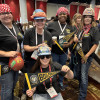Labor reporter assesses the decline of unions — and their chances for survival
PHIL DINE IS something of a rarity in journalistic circles. As a labor reporter for the St. Louis Post-Dispatch, he has spent much of the last two decades covering organized labor. Most commercial newspapers across the country did away with labor reporters years ago — or at best have chosen to handle the labor beat as an add-on to a reporter’s regular assignments.
That is precisely why Dine’s new book, “State of the Unions: How Labor Can Strengthen the Middle Class, Improve Our Economy, and Regain Political Influence” (McGraw-Hill, 2007), deserves a close look by anyone who cares about labor unions. Dine is the real deal, a reporter who jumped into the trenches with organized labor, writing about its achievements as well as its failures, its champions as well as its culprits. He has documented the struggles of rank-and-file union members and their leadership at the local, regional, and national levels. And he has observed keenly the forces — internal as well as external — that threaten labor’s existence. In the process, Dine has twice been nominated for Pulitzer Prize awards for labor coverage.
Who better to assess labor’s decline and identify strategies for its survival?
Dine’s assessment is grim. He writes: “A powerful labor movement that once moved workers into the middle class is now powerless to prevent people from falling out of it.” This statement may be over-general, but it certainly applies to millions of workers — especially in the manufacturing sector — whose jobs have been shipped overseas.
Bad trade deals, hostile labor boards, and an indifferent, biased media all factor into labor’s decline, Dine concedes. But labor itself is not without fault. In Dine’s view, unions have not made their issues part of the American dialogue. “What’s puzzling about labor’s failure to deliver its message,” he writes, “is that most people agree with almost all of its policy goals.” He adds, “The lack of an effective voice has had three far-reaching consequences for labor: it has skewed public policies related to workers, the workplace, and union rights; it has created a vacuum in terms of public perception that allows labor’s adversaries to define it in negative ways; and, as a result, it has jeopardized labor’s survival.”
Dine is particularly sensitive to labor’s relationship with the media. He describes a vicious cycle that works something like this: Unions don’t trust the media, so they do not cooperate with reporters; reporters and editors respond by giving less coverage to unions; this strengthens labor’s belief that the media is biased, so unions cooperate even less than before — and get even less coverage.
Not surprisingly, Dine prescribes more proactive media relations, with more access to union leaders, as part of any solution to labor’s woes.
Dine uses two news stories he covered to illustrate fundamental labor strengths — strengths unions can draw upon to regain power. The first story describes how fire fighter locals throughout Iowa pulled an upset victory for underdog presidential candidate John Kerry during the 2004 caucus. Dine says the fire fighters’ discipline, unity, and organizational skills were responsible for producing an unexpected turnout for Kerry, surprising political pundits as well as the other candidates.
The second story describes how 900 poor black women employed by Delta Pride, a catfish farming operation in Mississippi, won better wages and working conditions from their all-white, anti-union employers. Dine attributes their success to the United Food and Commercial Workers’ skillful use of a boycott, its ability to frame the issue for the media, and its decision to allow the women to make their case for fairness and justice from the bottom up — rather than from the union leadership down.
“If the labor movement does revitalize itself,” Dine writes, “It won’t be because its leaders have discovered a magic formula…it will be because labor is out telling its story in a way that captures imagination, evokes a sense of mission and achievement, and makes clear why a robust union movement is not only relevant but in the public interest.”
Learn more about State of the Unions online at www.philipdine.com.







